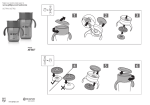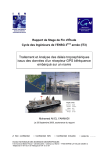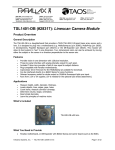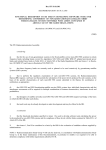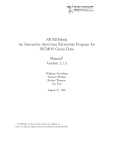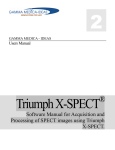Download Assimilated SCIAMACHY NO2 fields HDF data file user manual
Transcript
Assimilated SCIAMACHY NO2 fields HDF data file user manual Folkert Boersma and Henk Eskes 6 February 2004 1 Contents Content of the ”no2trackyyyymmdd.hdf” files 3 The use of the averaging kernel 6 IDL sample code to read the NO2 fields 7 2 Content of the ”no2trackyyyymmdd.hdf” files The no2trackyyyymmdd.hdf contains data on NO2 retrieved during one day. The file is organised as follows: • SDSGlobal Attribute (containing data on the file) • Vdata(the actual data) SDS Global Attributes An example of the SDS Global Attributes is given below. Data created by refers to the version of the assimilation code used to produce the NO2 fields. SDS Global Attributes Name Value __________________________________________________________________________ Author H.J. Eskes, K.F. Boersma Affiliation KNMI (Royal Netherlands Meteorological Institute) Email [email protected], [email protected] Data_created_by TM3-NO2A, version 1.01 Creation_date 15 Jan 2004 Unit_of_NO2_column 1e15 molecules/cm2 VData The Vdata is organized as follows: • pressure_grid(from TM3) • NO2_ymmddttt(contains the main NO2 retrieval data for one track (orbit)) • GEO_ymmddttt(contains all geometric data associated with retrievals in this track) • ANC_ymmddttt(contains all ancillary data associated with retrievals in this track) The VData always contains only one pressure grid. The pressure grid gives the 31 pressure levels that were used to compute the averaging kernel. The VData Table Attribute gives the equation required to convert the a lev, b lev and surface pressure numbers into pressure levels (in Pascal) representative of the layer of the averaging kernel. The equation is: p = a_lev + p_surf * b_lev (1) and p surf is stored in the NO2 ymmddttt. The VData may contain as many as 20 (maximum number of orbits in one day) pieces of NO2 ymmddttt, GEO ymmddttt and ANC ymmddttt. The array NO2 ymmddttt is accompanied by a VData Table Attribute that contains the name of the track, and the start- and end time (year, month, day, hour, minutes, and seconds) as follows: 3 VData Table Attributes Name Value __________________________________________________________________________ track_identifier 30417035 start_time 2003, 4, 16, 23, 42, 57 end_time 2003, 4, 17, 0, 25, 17 In this case, the first track of April 17, 2003, happened to start on the previous day, but since it ended on April 17, it is attributed to this day. The main data table is NO2 ymmddttt and it contains 16 fields. They are summarized below and commented on. date time lon lat vcd sigvcd vcdtrop sigvcdt vcdstrat sigvcds fltrop psurf sigvcdak sigvcdtak kernel ghostcol Date of SCIAMACHY retrieval (yyymmdd) Time of measurement ((h)hmiss) Center longitude of pixel Center latitude of pixel Retrieved total vertical column density (in 1e15 molec. cm-2) Error in the total vertical column density (in 1e15 molec. cm-2) Retrieved tropospheric vertical column density (in 1e15 molec. cm-2) Error in the tropospheric vertical column density (in 1e15 molec. cm-2) Assimilated stratospheric vertical column density (in 1e15 molec. cm-2) Error in the stratospheric vertical column density (in 1e15 molec. cm-2) Flag that indicates if tropospheric retrieval was meaningful; 0 = yes, -1 = no Surface pressure of the pixel (in Pa) Error in total vertical column density without profile error contribution (in 1e15 molec. cm-2) Error in tropospheric vertical column density without profile error contribution, i.e. when averaging kernel information is used (in 1e15 molec. cm-2) Averaging kernel of 31 fields corresponding to 31 pressure levels as defined in pressure_grid Ghost column, defined as the total vertical column below the cloud top (in 1e15 molec. cm-2) GEO ymmddttt contains 6 fields. They are summarized below and commented on. sza vza raa ssc loncorn latcorn satellite solar zenith angle satellite viewing zenith angle satellite relative azimuth angle; defined as SCIAMACHY subset counter, 0 = Nadir, 3 = Backscan (rejected), 7 = Last most westerly forward pixel longitudes of the four corners of the pixel latitudes of the four corners of the pixel ANC ymmddttt contains 10 fields that are of meant for advanced users. They are summarized below and commented on. scd IASB slant column density from IASB (in 1e15 molec. cm-2)) 4 amf amftrop amfgeo scdstr clfrac cltpres albclr crfrac ltropo total air-mass factor used to compute vcd (= scd / amf) tropospheric air-mass factor used to compute vcdtrop (= [scd-scdstr] / amftrop ) geometrical air-mass factor stratospheric slant column density (= amfgeo * vcdstrat ) cloud fraction from FRESCO cloud top pressure from FRESCO surface albedo for clear part of the pixel from TOMS/GOME database cloud radiance fraction, i.e. percentage of light coming from the cloudy part of the scene level in TM3 where tropopause occurs 5 The use of the averaging kernel Users will generally have a range of interests in employing the data. We can basically distinguish straightforward users with a certain degree of faith in our measurements from more advanced users. The last group is generally involved in detailed model to measurement comparisons and/or satellite validation studies. (1) Basic users will be mainly interested in the total NO2 column vcd and its error sigvcd and in the tropospheric column vcdtrop and its error sigvcdt. These users may for instance want to qualitatively check preliminary results of some field experiment with the retrieved NO2 columns. (2) Advanced users may be interested not only in the columns and their errors, but also in the relation between the (modeled or measured) ’true’ vertical distribution of NO2 and the retrieved quantity. These users will also want to use the averaging kernel that provides the link between (modeled) reality and retrieval (for more details on the DOAS averaging kernel, read Eskes and Boersma [2003]. For example, those who are interested in a model - SCIAMACHY comparison may want to map the modeled NO 2 profiles via the averaging kernel to what SCIAMACHY would retrieve (y is the ’retrieved’ quantity) as follows: y =A·x (2) with A the averaging kernel, a 31-element vector specified at pressure levels described in the previous section, and x the vertical distribution of NO2 (in partial subcolumns) from a CTM (or from colocated validation measurements) at the same 31 pressure levels. The user thus needs to either convert his or her vertical (subcolumn) NO2 profile to the pressure grid of the averaging kernel in order to construct a vertical column y as would be retrieved by SCIAMACHY. Note that the columns and errors [Boersma et al., 2004] given in the dat table are in 1015 molec. cm−2 . In principle, a user may also interpolate the averaging kernel vector to the grid of his or her x. However, since the AK is so sensitive to changes on small spatial scales, for instance due to rapid cloud changes, one should be very careful in interpolating the averaging kernel vector. For these calculations, the error in y will reduce to sigvcdak since uncertainties on the vertical NO 2 profile are no longer accounted for. A user should be aware that he or she should no longer use sigvcd, because this error includes a retrieval-specific profile error term that can now be discarded. Alternatively, a user may be interested in the tropospheric NO2 load alone. For tropospheric retrievals (with y now the tropospheric column), equation (2) reduces to: y = Atrop · xtrop (3) with Atrop the averaging kernel for tropospheric retrievals, defined as: Atrop = A · amf amftrop (4) and xtrop the profile shape for tropospheric levels (levels up to level number ltropo as specified in ANC ymmddttt. The pressure at level ltropo does not necessarily correspond to the tropopause pressure but rather gives the pressure of the layer in which the tropopause occurs according to the WMO 1985 tropopause criterium. 6 IDL sample code to read the NO2 fields The following IDL program reads an HDF data file and stores the data in a structure no2. pro read_scia_no2 ;------------------------------------------------------------------; Read data from GOME HDF file between two times "date1" and "date2" ; and stores in structure "no2" ; ;"maxorbits" maximum number of orbits in a file ;"maxpix" maximum number of pixels in an orbit ;"nplevs" number of pressure levels in TEMIS SCIA data ; ; Folkert Boersma, KNMI, February 2004 ;------------------------------------------------------------------maxorbits = 20 maxpix = 5000 nplev = 31 file = ’no2track20030417.hdf’ ; Define structure for GOME data no2 = { $ norbits : 0, $ npix : intarr(maxorbits), $ a_lev : make_array(nplev,/float,value=-999),$ b_lev : make_array(nplev,/float,value=-999),$ date : make_array(maxorbits,maxpix,/string,value=-999), $ time : make_array(maxorbits,maxpix,/string,value=-999), $ lon : make_array(maxorbits,maxpix,/float,value=-999.9), $ lat : make_array(maxorbits,maxpix,/float,value=-999.9), $ vcd : make_array(maxorbits,maxpix,/float,value=-999.9), $ sigvcd : make_array(maxorbits,maxpix,/float,value=-999.9), $ vcdtrop : make_array(maxorbits,maxpix,/float,value=-999.9), $ sigvcdt : make_array(maxorbits,maxpix,/float,value=-999.9), $ vcdstrat : make_array(maxorbits,maxpix,/float,value=-999.9), $ sigvcds : make_array(maxorbits,maxpix,/float,value=-999.9), $ fltrop : make_array(maxorbits,maxpix,/int,value=-999.9), $ psurf : make_array(maxorbits,maxpix,/int,value=-999.9), $ sigvcdak : make_array(maxorbits,maxpix,/float,value=-999.9), $ sigvcdtak : make_array(maxorbits,maxpix,/float,value=-999.9), $ kernel : make_array(maxorbits,maxpix,nplev,/float,value=-999),$ ghostcol : make_array(maxorbits,maxpix,/float,value=-999.9), $ sza : make_array(maxorbits,maxpix,/float,value=-999.9),$ vza : make_array(maxorbits,maxpix,/float,value=-999.9),$ raa : make_array(maxorbits,maxpix,/float,value=-999.9),$ ssc : make_array(maxorbits,maxpix,/int,value=-999.9), $ loncorn : make_array(maxorbits,maxpix,4,/float,value=-999),$ 7 latcorn scd amf amftrop amfgeo scdstr clfrac cltpres albclr crfrac ltropo : : : : : : : : : : : make_array(maxorbits,maxpix,4,/float,value=-999),$ make_array(maxorbits,maxpix,/float,value=-999),$ make_array(maxorbits,maxpix,/float,value=-999),$ make_array(maxorbits,maxpix,/float,value=-999),$ make_array(maxorbits,maxpix,/float,value=-999),$ make_array(maxorbits,maxpix,/float,value=-999),$ make_array(maxorbits,maxpix,/float,value=-999),$ make_array(maxorbits,maxpix,/float,value=-999),$ make_array(maxorbits,maxpix,/float,value=-999),$ make_array(maxorbits,maxpix,/float,value=-999),$ make_array(maxorbits,maxpix,/int,value=-999)} id = hdf_sd_start(file,/read) ; The HDF_SD_FILEINFO procedure retrieves the number of datasets and ; global attributes in an HDF file. hdf_sd_fileinfo,id,datasets,attributes help,datasets,attributes iret = 0 for i=0,attributes-1 do begin hdf_sd_attrinfo,id,i,name = name, data = d command = name+’=d’ iret = execute(command) print, ’Retrieved Attribute:’,name,’ ’,d endfor hdf_sd_end,id ; Open file and initialize vdata reading file_id=hdf_open(file,/read) vd_id = -1 vd_handle = -1 end_of_file=0 vds = hdf_vd_lone(file_id) nvds = n_elements(vds) if (nvds eq 0) then begin print, ’ERROR: No vdatas found in file’ stop endif ; Loop over vdatas for i=0,attributes+nvds-1 do begin vd_id = hdf_vd_getid(file_id,vd_id) vd_handle=hdf_vd_attach(file_id,vd_id,/read) hdf_vd_get,vd_handle,nfields=nf,name=vd_name,count=count,fields=fields ; Read pressure fields a_lev and b_lev into variables if (strmid(vd_name,0,4) eq ’pres’ ) then begin 8 for j=0,nf-1 do begin hdf_vd_getinfo,vd_handle,j,name=fieldname,size=size,type=type name = strcompress(fieldname,/remove_all) iret = execute(’nread=hdf_vd_read(vd_handle,’+$ name+’,fields="’+fieldname+’")’) if (iret ne 1) then begin print,’Error dataset’,i stop endif endfor no2.a_lev(0:nplev-1) no2.b_lev(0:nplev-1) endif = transpose(a_lev) = transpose(b_lev) if (strmid(vd_name,0,4) eq ’NO2_’ ) then begin if (vd_name ne ’start_time’ and vd_name ne ’end_time’) then begin track_date = long64(strmid(vd_name,strlen(vd_name)-8,8)) track_date = track_date * 1000 + 20000000000000 endif ; Check whether orbit fits in data structure if (no2.norbits ge maxorbits) then begin print,no2.norbits print, ’ERROR: more orbits in file than’, maxorbits stop endif if (count gt maxpix) then begin print, ’ERROR: orbit’, no2.norbits+1,’ has more pixels (’, $ count, ’ ) than’, maxpix stop endif ; Read fields into variables for j=0,nf-1 do begin hdf_vd_getinfo,vd_handle,j,name=fieldname,size=size,type=type name = strcompress(fieldname,/remove_all) iret = execute(’nread=hdf_vd_read(vd_handle,’+$ name+’,fields="’+fieldname+’")’) if (iret ne 1) then begin print,’Error dataset’,i stop endif endfor ; Add variables to structure no2.date(no2.norbits,0:count-1) no2.time(no2.norbits,0:count-1) no2.lon(no2.norbits,0:count-1) no2.lat(no2.norbits,0:count-1) = = = = 9 date time lon lat no2.vcd(no2.norbits,0:count-1) no2.sigvcd(no2.norbits,0:count-1) no2.vcdtrop(no2.norbits,0:count-1) no2.sigvcdt(no2.norbits,0:count-1) no2.vcdstrat(no2.norbits,0:count-1) no2.sigvcds(no2.norbits,0:count-1) no2.fltrop(no2.norbits,0:count-1) no2.psurf(no2.norbits,0:count-1) no2.sigvcdak(no2.norbits,0:count-1) no2.sigvcdtak(no2.norbits,0:count-1) no2.kernel(no2.norbits,0:count-1,*) no2.ghostcol(no2.norbits,0:count-1) no2.npix(no2.norbits) = = = = = = = = = = = = = vcd sigvcd vcdtrop sigvcdt vcdstrat sigvcds fltrop psurf sigvcdak sigvcdtak transpose(kernel) ghostcol count endif if (strmid(vd_name,0,4) eq ’GEO_’) then begin ; Check whether orbit fits in data structure if (no2.norbits ge maxorbits) then begin print, ’ERROR: more orbits in file than’, maxorbits stop endif if (count gt maxpix) then begin print, ’ERROR: orbit’, no2.norbits+1,’ has more pixels (’, $ count, ’ ) than’, maxpix stop endif ; Read fields into variables for j=0,nf-1 do begin hdf_vd_getinfo,vd_handle,j,name=fieldname,size=size,type=type name = strcompress(fieldname,/remove_all) iret = execute(’nread=hdf_vd_read(vd_handle,’+$ name+’,fields="’+fieldname+’")’) if (iret ne 1) then begin print,’Error dataset’,i stop endif endfor ; Add variables to structure no2.sza(no2.norbits,0:count-1) no2.vza(no2.norbits,0:count-1) no2.raa(no2.norbits,0:count-1) no2.ssc(no2.norbits,0:count-1) no2.loncorn(no2.norbits,0:count-1,*) no2.latcorn(no2.norbits,0:count-1,*) endif if (strmid(vd_name,0,4) eq ’ANC_’) then begin 10 = = = = = = sza vza raa ssc transpose(loncorn) transpose(latcorn) ; Check whether orbit fits in data structure if (no2.norbits ge maxorbits) then begin print, ’ERROR: more orbits in file than’, maxorbits stop endif if (count gt maxpix) then begin print, ’ERROR: orbit’, no2.norbits+1,’ has more pixels (’, $ count, ’ ) than’, maxpix stop endif ; Read fields into variables for j=0,nf-1 do begin hdf_vd_getinfo,vd_handle,j,name=fieldname,size=size,type=type name = strcompress(fieldname,/remove_all) iret = execute(’nread=hdf_vd_read(vd_handle,’+$ name+’,fields="’+fieldname+’")’) if (iret ne 1) then begin print,’Error dataset’,i stop endif endfor ; Add variables to structure no2.scd(no2.norbits,0:count-1) no2.amf(no2.norbits,0:count-1) no2.amftrop(no2.norbits,0:count-1) no2.amfgeo(no2.norbits,0:count-1) no2.scdstr(no2.norbits,0:count-1) no2.clfrac(no2.norbits,0:count-1) no2.cltpres(no2.norbits,0:count-1) no2.albclr(no2.norbits,0:count-1) no2.crfrac(no2.norbits,0:count-1) no2.ltropo(no2.norbits,0:count-1) no2.norbits endif hdf_vd_detach, vd_handle endfor hdf_close, file_id end 11 = = = = = = = = = = = scd amf amftrop amfgeo scdstr clfrac cltpres albclr crfrac ltropo no2.norbits+1 References [1] Eskes, H. J., and K.F. Boersma, Averaging kernels for DOAS total-column satellite retrievals, Atmos. Chem. Phys., 3, 1285-1291, 2003. [2] Boersma, K. F., H. J. Eskes, and E. J. Brinksma, Error analysis for tropospheric NO 2 retrieval from space, J. Geophys. Res., 109, doi:10.1029/2003JD003962, 2004. 12













